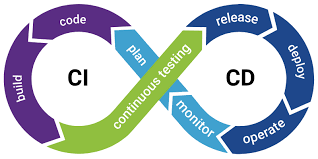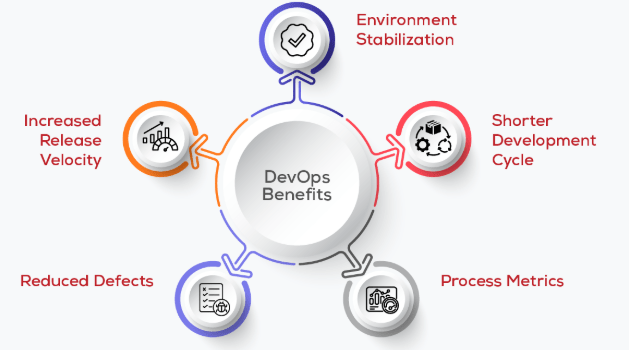
- Introduction to DevOps
- How DevOps Transforms Software Development
- Continuous Integration and Continuous Deployment (CI/CD)
- Improved Collaboration Between Development and Operations Teams
- Automation and Infrastructure as Code (IaC)
- Faster Time-to-Market for Software Releases
- Enhanced Security and Compliance in DevOps
- DevOps Monitoring and Performance Optimization
- Cost Savings and Resource Efficiency
- Better Scalability and Flexibility
- Common Challenges in DevOps Adoption
- Best Practices for Successful DevOps Implementation
Introduction to DevOps
DevOps is a set of practices, tools, and cultural philosophies that enhance the collaboration and integration between software development (Dev) and IT operations (Ops) teams. Its primary goal is to shorten the software development lifecycle while ensuring high-quality software delivery. By fostering better collaboration, communication, and automation, DevOps aims to enable faster, more reliable, and more efficient development processes, ultimately leading to improved business outcomes. In the past, development and operations teams often worked in silos, leading to miscommunication, delays, and inefficiencies. DevOps breaks down these barriers by encouraging a culture of shared responsibility, continuous feedback, and continuous improvement. It emphasizes automation, monitoring, and modern technologies to ensure that applications can be developed, tested, deployed, and maintained at high velocity.
How DevOps Transforms Software Development
DevOps revolutionizes software development by fostering an environment of collaboration and continuous improvement. This transformation occurs in several key ways:
- Collaboration Between Teams: DevOps promotes a shift from siloed teams to cross-functional collaboration, where developers, operations, and quality assurance (QA) teams work together throughout the software lifecycle. This leads to faster issue identification and resolution.
- Continuous Feedback and Improvement: By integrating feedback loops into every stage of the development process, DevOps helps teams continuously learn from each release, which allows them to make quick adjustments and improvements.
- Automation of Processes: Many manual and repetitive tasks, including testing, deployment, and infrastructure provisioning, are automated, reducing human error and increasing efficiency.
- Faster Development Cycles: DevOps speeds up the development lifecycle by implementing Continuous Integration (CI) and Continuous Deployment (CD) pipelines, allowing code to be pushed to production faster and with fewer errors.
- Better Quality and Reliability: DevOps emphasizes automated testing and continuous monitoring, ensuring that code quality is maintained throughout development and that applications are stable and reliable when deployed.
Continuous Integration and Continuous Deployment (CI/CD)
One of the core principles of DevOps is Continuous Integration (CI) and Continuous Deployment (CD). These practices aim to streamline the development process and ensure that new features, updates, and fixes are delivered quickly and with high quality.
Continuous Integration (CI)CI frequently merges code changes from different developers into a shared repository. This process helps identify integration issues early and ensures the codebase remains deployable. CI involves:
- Automated Testing: Every code change is automatically tested using unit, integration, and other automated tests to ensure that it does not break the application.
- Frequent Code Commits: Developers commit small chunks of code regularly, allowing for more manageable changes and reducing the chances of significant integration conflicts. Continuous Deployment (CD)
- Frequent Releases: Software updates are delivered quickly, reducing the time it takes to bring new features to end users.
- Reduced Downtime: Automated deployment ensures a consistent and predictable process for deploying code changes, minimizing downtime and service disruptions.
CD takes CI a step further by automating the deployment of code changes to production environments. With CD, once the code passes the necessary automated tests, it is automatically deployed without manual intervention. This enables:

Improved Collaboration Between Development and Operations Teams
In traditional software development environments, developers and operations teams often worked in isolation, leading to communication barriers, delays, and inefficiencies. DevOps bridges this gap by encouraging collaboration between both teams, resulting in several benefits:
- Shared Responsibility: In DevOps, developers and operations professionals share responsibility for an application’s entire lifecycle, from development to deployment and maintenance. This promotes a culture of collaboration and accountability.
- Faster Issue Resolution: With improved collaboration, teams can quickly address issues. Developers can work alongside operations teams to troubleshoot production issues and identify real-time root causes.
- Enhanced Communication: DevOps tools and platforms, such as version control systems, chat systems, and CI/CD pipelines, enable seamless team communication. Everyone involved can track progress, raise issues, and offer solutions in a shared environment.
- Continuous Learning: By collaborating continuously, team members gain insights into the application’s development and operational aspects. This encourages a culture of cross-training, allowing teams to share knowledge and improve their skills.
Automation and Infrastructure as Code (IaC)
Automation is a cornerstone of DevOps, eliminating the need for manual intervention in repetitive tasks, leading to increased efficiency and fewer human errors. Infrastructure as Code (IaC) plays a crucial role in this automation journey by managing and provisioning IT infrastructure through code rather than manual processes or graphical interfaces. IaC ensures consistent environments across development, staging, and production, reducing discrepancies and preventing “works on my machine” issues. It also enables version control for infrastructure, allowing teams to track changes, roll back configurations, and collaborate more effectively. Additionally, IaC enhances scalability, making it easier to adjust infrastructure based on demand with cloud services like AWS, Azure, and Google Cloud offering automation tools for provisioning and management. DevOps relies on various automation tools to streamline infrastructure and application deployments. Terraform, an open-source IaC tool, facilitates provisioning and managing cloud infrastructure across multiple providers. Ansible automates software provisioning and configuration, while Chef and Puppet help define infrastructure configurations and policies through code, ensuring efficient and automated infrastructure management.
Faster Time-to-Market for Software Releases
DevOps significantly reduces the time it takes to develop, test, and release software. Key factors contributing to faster time-to-market include:
- Automation of Repetitive Tasks: DevOps reduces manual effort and accelerates the development pipeline by automating testing, deployment, and infrastructure provisioning.
- Parallel Development: DevOps enables parallel development processes, allowing multiple teams to work on different parts of an application simultaneously, increasing the overall development speed.
- Faster Feedback Loops: Continuous feedback through CI/CD pipelines allows teams to quickly address issues and improve the application based on real-time testing results.
- Shorter Release Cycles: DevOps practices facilitate shorter release cycles, allowing software to be deployed more frequently and with fewer issues.
Enhanced Security and Compliance in DevOps
Security is crucial in DevOps, especially as organizations adopt continuous delivery and deployment. DevSecOps integrates security into every phase of the DevOps lifecycle, ensuring a proactive approach to risk management. Security automation enables DevOps teams to automate security testing, vulnerability scanning, and compliance checks within the CI/CD pipeline, ensuring code security before deployment. The “shift-left” approach addresses security concerns earlier in development rather than waiting until deployment, helping identify vulnerabilities and compliance issues sooner to reduce risks. Continuous monitoring tools integrated into DevOps pipelines proactively detect and mitigate security threats, ensuring applications remain secure even after deployment. Additionally, DevOps practices support regulatory compliance by embedding compliance checks into the development process, ensuring adherence to industry standards before code is released.
DevOps Monitoring and Performance Optimization
Monitoring is crucial for ensuring that applications perform as expected in production environments. DevOps teams use monitoring tools to track application health, identify performance bottlenecks, and optimize resource utilization.
- Real-Time Monitoring: Tools like Prometheus, Grafana, and Datadog allow teams to monitor key metrics in real time, enabling quick identification of issues such as performance degradation, high latency, or resource exhaustion.
- Log Management: ELK Stack (Elasticsearch, Logstash, Kibana) and Splunk are popular log management tools used in DevOps to aggregate logs from different systems. These tools provide insights into the behavior of applications and infrastructure.
- Performance Optimization: Continuous monitoring provides data that can be used to optimize the application’s performance, whether through code optimization, better infrastructure scaling, or tuning application configurations.

Cost Savings and Resource Efficiency
DevOps helps organizations reduce costs and improve resource efficiency through optimized infrastructure, minimized downtime, and effective cloud resource management. Automation and Infrastructure as Code (IaC) allow teams to provision and de-provision infrastructure on demand, ensuring resources are used efficiently and only when needed. By streamlining deployment processes, DevOps minimizes application downtime, leading to smoother releases and significant cost savings. Additionally, DevOps enables organizations to maximize cloud services by scaling infrastructure based on demand, preventing unnecessary expenses, and optimizing resource utilization.
Better Scalability and Flexibility
DevOps enables organizations to scale their applications and infrastructure more efficiently by:
- Automated Scaling: Infrastructure can automatically scale in response to traffic demand, reducing the risk of over-provisioning or under-provisioning.
- Flexibility in Deployment: With DevOps practices, organizations can deploy applications across various environments (e.g., on-premise, cloud, hybrid), ensuring flexibility to adapt to changing requirements.
Common Challenges in DevOps Adoption
While DevOps offers numerous benefits, organizations often face challenges during adoption, including cultural resistance, skill shortages, tool integration complexities, and legacy system constraints. Shifting to DevOps requires a change in established workflows and mindsets, which can be met with resistance from teams accustomed to traditional approaches. Additionally, DevOps demands specialized skills, making it difficult to find professionals with expertise in both development and operations. Integrating various DevOps tools and ensuring seamless interoperability can also be complex. Moreover, transitioning legacy systems to a DevOps culture presents challenges, especially when existing infrastructure is not designed for automation or scalability.
Best Practices for Successful DevOps Implementation
Foster Collaboration and Communication: Break down silos and encourage continuous collaboration between development, operations, and security teams.
- Automate Everything: Automate testing, deployment, infrastructure provisioning, and monitoring to improve efficiency and consistency.
- Implement CI/CD Pipelines: Set up CI/CD pipelines to automate code integration and deployment, enabling faster and more reliable releases.
- Use Infrastructure as Code: Manage infrastructure through code to ensure consistent and repeatable environments.
- Monitor Continuously: Use real-time monitoring and logging to address performance issues and ensure application reliability proactively.
- Embrace a Culture of Continuous Improvement: Foster a culture of learning and improvement, where feedback is valued and mistakes are seen as opportunities for growth.
By following these best practices, organizations can successfully implement DevOps and reap the benefits of faster, more efficient software development.





